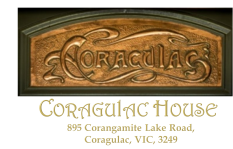Coragulac House History
1872 - Current
Following is the book forward written by Historian and Author Jennifer O'Donnell who has written a book detailing the life and times of the families who proudly took residence in Coragulac House over it's 150 year history
Coragulac or Coragulac House as it later became was not built until the 1870s but its story begins in the 1840s and is inextricably entwined with the story of three other great houses in the area – Corangamoorah or The Hill, Cororooke and Glen Alvie.
The founding father, William Robertson, one of the earliest settlers in the Colac district but a largely absentee landowner until 1865. In about 1870, he divided his vast estate among his four sons, three of whom proceeded to build their own mansions.
George Pringle Robertson inherited what became Coragulac, built to plans by architects Davidson and Henderson. Trading as Robertson Brothers, the brothers built upon their father’s pioneering work as cattle breeders becoming famous for the quality of their stock throughout the east coast of Australia. The Robertson family, father and sons, also contributed to the development of the Colac community Closer settlement, the proximity to Melbourne markets and the advance of the railways, saw dairying and potato and onion growing take over from pastoralism. These latter pursuits were heavily promoted by the next two owners of Coragulac and resulted in the break-up of Robertson brothers’ landholdings.
Andrew Spence Chirnside became the second owner of Coragulac in 1903 made extensive structural alterations and additions to the mansion. Made in the Art nouveau style, only the north façade remained recognizable while the interior was radically changed. He also sold-off more land and was prominent in Colac affairs.
While Chirnside pursued dairying, Thomas Baker, the third owner, broke up the property further and promoted onion growing in the area. He too was very involved in local affairs including the advancement of the railways to service the needs of farmers.
The fourth owner, Len Ralton, rescued Coragulac from a period of neglect and undertook restoration work. World War Two intervened and shortly after it ended Coragulac was sold.
After a brief occupancy by Gordon Robinson, Coragulac passed into the hands of the Matthews family who remained in the house for over 60 years.
In 2013, Garry and Sharyn Gibson bought Coragulac and set about meticulously returning the mansion to its days of glory.
In the 1885 ‘The Vagabond’ toured the Western District, which of course included Colac, and has left behind delightful accounts of everything he saw. In 1889, Isaac Hebb wrote a detailed history of Colac, drawing amongst other sources, on the memories and accounts of often still living pioneers. These provide a wealth of information to re-construct the past.
Inextricably bound to Coragulac’s story are also those of the Gulidjan people, the disappearing lakes, as well as St Andrew’s Presbyterian Church (now Colac Uniting Church) and the now defunct Colac Polo Club.
The author is much indebted to the Robertson family archive, Colac and District Historical Society and a number of private collections which have provided invaluable material enabling the reconstruction of Coragulac’s early decades.
The book is a detailed social history of the life and times of those who have lived in the homestead and the changes that have made the homestead what it is today written by historian Jennifer O'Donnell
Coragulac House book is now available from Coragulac House and participating book stores in Colac
Book Foreword - Coragulac House by Jennifer O'Donnell
Gallery of historical images of Coragulac House 1872 - 2013
Book your accommodation package now!
Telephone |
|
